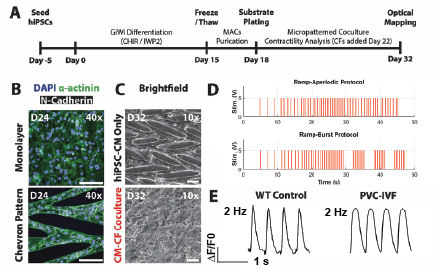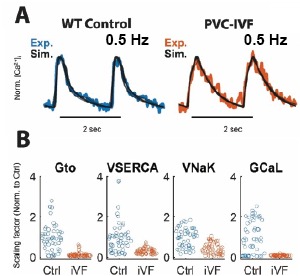Final ID: Mo071
Engineered Platform to Uncover Cellular Cross-Talk and Arrhythmogenesis in Idiopathic Ventricular Fibrillation (IVF)
Abstract Body: Background: Idiopathic VF (IVF) represents an unmet clinical need with ~50% of patients having no known monogenic cause. This has resulted in the lack of an appropriate experimental model system, limiting effective treatment through an evidence-based approach. Within IVF, several subphenotypes have emerged through Deep Phenotyping. We recruited patients with Purkinje cell premature ventricular contraction-driven IVF (PVC-IVF) to generate induced pluripotent stem cells (iPSCs).
Aim: To characterize PVC-IVF patient-specific iPSCs using a physiologically relevant engineered in vitro model. We hypothesize this model will allow for mechanistic characterization of PVC-IVF.
Methods: Patient-specific iPSC-cardiomyocytes (CMs) and iPSC-cardiac fibroblasts (CFs) were plated on 10 kPa polydimethylsiloxane (PDMS) culture platform with Matrigel in either monolayers or interconnected 40 µm lanes (Fig. 1A). Optical mapping was used to characterize Ca2+ handling and action potentials. Control cells were from non-diseased persons.
Results: CM-CF coculture results in a monolayer yet maintains the underlying organization (Fig. 1B-C). Patterned constructs have increased conduction velocities and anisotropy. Custom stimulation protocols were developed to probe arrhythmia susceptibility and restitution kinetics (Fig. 1D-E). A genetic algorithm was used to optimize a biophysically detailed CM model which enabled identification of differential model parameters between IVF and control data (Fig. 2A-B). These data will be used to develop a Ca2+ handling–conduction–contractility paradigm specific to PVC-IVF as well as a mechanistic-based understanding of the disorder.
Conclusions: Topography informs CM structure, while CFs remodel the matrix to form a monolayer, enabling full field electrophysiological definition at the cell and tissue scale. The in vitro model provides a unique microenvironment to determine the arrhythmogenic mechanism of PVC-IVF.
Aim: To characterize PVC-IVF patient-specific iPSCs using a physiologically relevant engineered in vitro model. We hypothesize this model will allow for mechanistic characterization of PVC-IVF.
Methods: Patient-specific iPSC-cardiomyocytes (CMs) and iPSC-cardiac fibroblasts (CFs) were plated on 10 kPa polydimethylsiloxane (PDMS) culture platform with Matrigel in either monolayers or interconnected 40 µm lanes (Fig. 1A). Optical mapping was used to characterize Ca2+ handling and action potentials. Control cells were from non-diseased persons.
Results: CM-CF coculture results in a monolayer yet maintains the underlying organization (Fig. 1B-C). Patterned constructs have increased conduction velocities and anisotropy. Custom stimulation protocols were developed to probe arrhythmia susceptibility and restitution kinetics (Fig. 1D-E). A genetic algorithm was used to optimize a biophysically detailed CM model which enabled identification of differential model parameters between IVF and control data (Fig. 2A-B). These data will be used to develop a Ca2+ handling–conduction–contractility paradigm specific to PVC-IVF as well as a mechanistic-based understanding of the disorder.
Conclusions: Topography informs CM structure, while CFs remodel the matrix to form a monolayer, enabling full field electrophysiological definition at the cell and tissue scale. The in vitro model provides a unique microenvironment to determine the arrhythmogenic mechanism of PVC-IVF.
More abstracts on this topic:
Correlation between Plasma Adiponectin, Leptin Levels, and Adverse Outcomes in Hypertrophic Cardiomyopathy Patients
Younus Shifa, Choudhary Humais, Cheema Muhammad Hassan, Cheema Muhammad Hussnain, Hussain Alamdar, Fatima Noor, Zafar Aeman, Ali Aamir, Saleem Hamza, Hussain Tauseef
Analysis of Ventricular Fibrillation Waveform Response to Asphyxial Hemodynamics in an Infant Swine Model of Out-of-Hospital Cardiac ArrestJackson Aaron, Gumucio Jorge, Menegazzi James, Salcido David


